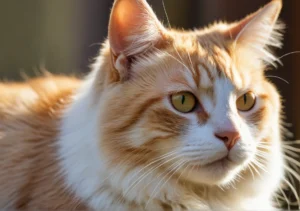Have you ever noticed that when you touch your cat’s back, it seems to ripple or move in waves? This phenomenon can be fascinating to observe, but have you ever wondered why it happens?
The movement of your cat’s back when you touch it is a natural reflex called the cutaneous trunci reflex.
What is the cutaneous trunci reflex?
Have you ever noticed that when you touch your cat’s back, their skin twitches or ripples? This fascinating reaction is known as the cutaneous trunci reflex. Essentially, this reflex causes the muscles beneath your cat’s skin to contract involuntarily when stimulated.
The cutaneous trunci reflex is a protective mechanism that helps cats in the wild by allowing them to quickly react to potential threats. When a predator tries to grab a cat from behind, this reflex causes the skin to twitch, making it harder for the predator to maintain a grip. It’s like a built-in survival mechanism that helps cats escape from danger.
So, the next time you see your cat’s back moving when you touch it, remember that it’s just their body’s way of protecting itself!
Why do cats have this reflex?
Cats have developed the cutaneous trunci reflex over generations of evolution as a way to survive in the wild. This reflex is especially useful for smaller cats who may be preyed upon by larger predators.
When you touch your cat’s back and trigger the cutaneous trunci reflex, it’s like tapping into their instinctual response to danger. Even though your fluffy feline friend may seem relaxed and domesticated, underneath it all, they still carry the genetic traits that helped their ancestors survive in the wild.
So, the next time you marvel at your cat’s twitching back, remember that it’s a reminder of their wild origins and the clever ways they have adapted to stay safe in their environment.
Additional Unique Insight:
One interesting fact about the cutaneous trunci reflex is that it’s not unique to cats. Many animals, including dogs, also exhibit this reflex. It’s a common survival mechanism that has been honed through evolution to help animals protect themselves from potential threats.
Keep this in mind next time you interact with your furry friend and see their back move in response to your touch!
Is the reflex present in all cats?
The cutaneous trunci reflex, commonly known as the “skin twitch” or “back-moving reflex,” is a natural response in most cats. It is a protective mechanism designed to help them detect potential threats or irritations on their skin. While this reflex is typically present in all cats, the intensity of the response may vary from one feline breed to another. Some cats may exhibit a more pronounced reaction, while others might have a more subtle response. However, in general, most cats will display this reflex when their back is touched.
Can the reflex be triggered in other ways?
In addition to touch, the cutaneous trunci reflex can also be triggered by various other stimuli. These can include changes in temperature, such as a sudden gust of cold air or a warm sensation on the skin. Additionally, loud noises or vibrations can also induce the reflex in some cats. Even visual stimuli, like sudden movements or objects coming close to the cat’s skin, can sometimes elicit the skin twitch. It’s essential to understand that each cat is unique, so what triggers the cutaneous trunci reflex in one feline may not have the same effect on another.
Other stimuli that can trigger the cutaneous trunci reflex in cats:
– Sudden changes in light intensity
– Certain fragrances or odors
– Tactile sensations like a light feather touch
By being aware of these additional triggers, you can better understand your cat’s behavior and reactions to different stimuli. Don’t be surprised if your feline friend’s back moves in response to more than just a touch; cats can be sensitive to a variety of sensory inputs.
Is the reflex beneficial to cats?
The cutaneous trunci reflex, where a cat’s back moves when you touch it, is actually a protective mechanism. In the wild, this reflex helps cats to quickly detect and escape from potential threats like insects or small predators. When you notice your cat’s back twitching, it’s a sign that their nerves are responding to stimuli: a built-in defense mechanism in action. However, in a domestic setting, this reflex might not serve the same purpose, but it still remains a natural response for your feline friend.
Advantages: 1. Quick Reaction: The reflex helps cats react swiftly to potential threats. 2. Physical Health: Stimulating the nerves can promote blood circulation and muscle relaxation. 3. Communication: It can be a form of communication, indicating sensitivity in a particular area.
Disadvantages: 1. Overstimulation: Continuous triggering of the reflex might lead to discomfort or annoyance for the cat. 2. Misinterpretation: It’s essential to understand when your cat enjoys the touch and when it’s best to refrain from it.
When observing this reflex in your cat, recognize it as a natural response that serves a vital purpose in the feline world.
How should you respond when you see this reflex in your cat?
When you notice your cat’s back twitching as you touch it, remember that this is a normal and instinctual response. It’s crucial to respect your cat’s boundaries and not force continued touch if they seem uncomfortable.
Respond accordingly: 1. Observe Body Language: Pay attention to your cat’s overall demeanor to gauge their comfort level. 2. Respect Limits: If your cat shows signs of discomfort, such as flattening their ears or twitching their tail, give them space. 3. Positive Reinforcement: Reward calm behavior with treats or affection to create a positive association with touch.
Remember, every cat is unique, and some may enjoy the sensation of the reflex more than others. By being attentive and respectful of your cat’s cues, you can ensure a positive and enriching interaction for both of you.
Extra Tip: To deepen your bond with your cat, try incorporating interactive play sessions as a way to strengthen trust and communication. This can help build a strong foundation for a harmonious relationship with your feline companion.
For further information on cat behavior and communication, you can refer to this resource on understanding cat body language: Understanding Your Cat’s Body Language
Can the reflex indicate underlying health issues?
When your cat’s back moves unexpectedly when you touch it, it could be a sign of the cutaneous trunci reflex. This reflex is a normal response in cats, and it helps protect them from potential threats by causing their skin to twitch in certain areas. However, changes in the reflex, such as an exaggerated or absent response, may signal underlying health issues.
If your cat consistently displays a heightened or diminished cutaneous trunci reflex, it’s essential to consult with a veterinarian. An abnormal reflex could potentially indicate nerve damage, skin irritation, or other health concerns that require medical attention. By addressing these issues promptly, you can ensure the well-being of your feline friend and prevent any potential complications.
Intriguing Fact: Cats are not the only animals that exhibit the cutaneous trunci reflex – rabbits, rats, and even humans have been observed to display this intriguing response to touch.
Discover whether the presence or absence of the cutaneous trunci reflex can signal any potential health concerns in your feline companion.
When your cat’s back moves involuntarily upon touch, it’s often due to the cutaneous trunci reflex, a normal response in felines. This reflex is a protective mechanism that helps cats react swiftly to potential threats or stimuli. However, changes in the reflex’s intensity or absence of response could indicate underlying health issues.
If you notice unusual reactions in your cat’s cutaneous trunci reflex, such as excessive twitching or lack of movement, it’s advisable to seek veterinary attention. These changes may signal nerve damage, skin problems, or other medical issues that require evaluation and treatment. By monitoring your cat’s reflexes and seeking prompt veterinary care if needed, you can ensure your cat’s health and well-being.
Helpful Tip: Ensuring regular veterinary check-ups can help detect any underlying health issues early on, including those that may affect the cutaneous trunci reflex. Regular exams can help maintain your cat’s overall health and catch any potential problems before they escalate.
Alex, a passionate animal lover, has experience in training and understanding animal behavior. As a proud pet parent to two dogs and three cats, he founded AnimalReport.net to share insights from animal experts and expand his knowledge of the animal kingdom.




